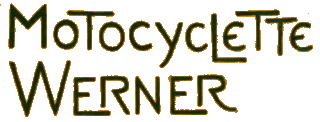



The new Werner Tricar, driven by a 5 h.p. water-cooled engine, with two vertical cylinders, and a two-speed gear.
Werner Control System.
All the single-cylinder Werner motor bicycles remain much the same as they were last year. In the two-cylinder, however, the compression is released not by depressing the inlet valves as in former models, but by raising the exhaust in the usual orthodox manner. The throttle, which formerly was operated in conjunction with the inlet valve depressor, is now worked by a lever on the tank. The 1906 Werner machines can be had fitted with magneto ignition if desired. In this case the magneto is driven by chain off the camshaft. For the first time in their existence, Werner Fibres have placed a really up-to-date tricar on the market, chiefly, we believe, at the instigation of their London house. This tricar reached the show last week in a somewhat unfinished state, since there has not been time to exhibit it in its final stage.
However, Werner Motors, Ltd., wisely decided to show the machine as it was, just to give a general idea as to what form it was proposed it should take. The engine is a double cylinder, 65 by 76, water-cooled, placed under the rear seat (we are describing the machine as Messrs. Young and Day explained it will be in its finality at the Paris Salon). It is set transversely, and drives through a leather-faced friction clutch to the gear box. On the propeller shaft are two pinions running loosely, which are always in mesh with a large and small bevel wheel - one for the low, the other for the high gear. Inside this shaft is another, on which there are expanding clutches, which, when the change-speed lever is moved, expand and fit into recesses internally cut on the pinion, locking either the low or high speed gearing, as the case may be. On the outer bearing of the gear box a single chain runs direct to the rear wheel. The rear seat is made to swing back so that the engine and gear box may easily be inspected. The frame, which is of channel steel, is suspended in the front on semi-elliptical springs.
The steering is geared down, and is effected by a wheel.
Push forward pedals control the clutch and rear brake. The petrol is carried under the rear seat, while the water tank is situated behind the front seat, the radiators being placed low down in the front of the machine. Both seats appear to be particularly comfortable, the upholstery being quite above the average.